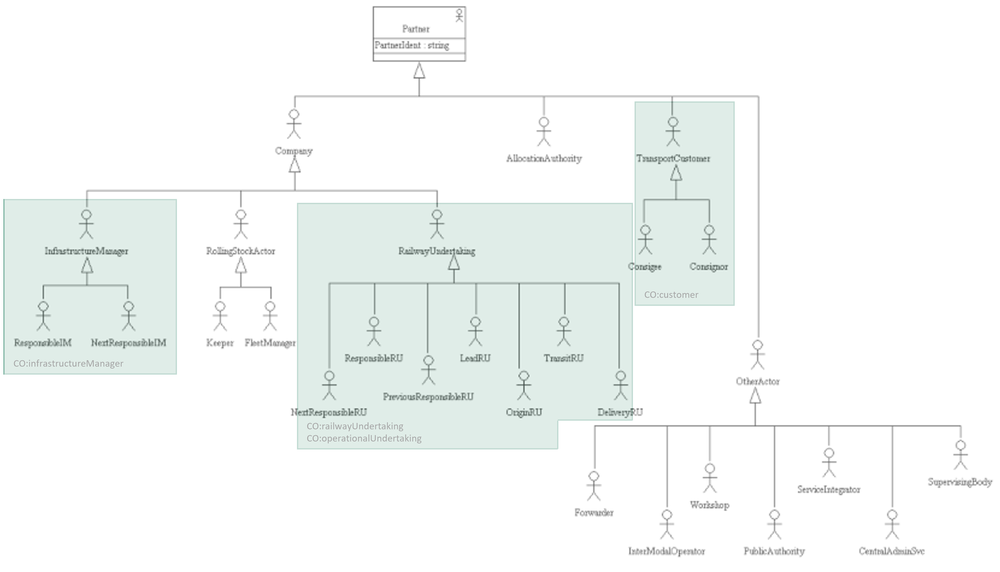CO:organizationalUnits: Difference between revisions
| [checked revision] | [checked revision] |
No edit summary |
No edit summary |
||
| (9 intermediate revisions by 3 users not shown) | |||
| Line 4: | Line 4: | ||
|parent = {{CO:Tag|metadata}} | |parent = {{CO:Tag|metadata}} | ||
|childs = {{CO:Tag|infrastructureManager}}, {{CO:Tag|vehicleManufacturer}}, {{CO:Tag|vehicleOperator}}, {{CO:Tag|customer}}, {{CO:Tag|railwayUndertaking}}, {{CO:Tag|operationalUndertaking}}, {{CO:Tag|concessionaire}}, {{CO:Tag|contractor}} | |childs = {{CO:Tag|infrastructureManager|organizationalUnits}}, {{CO:Tag|vehicleManufacturer}}, {{CO:Tag|vehicleOperator}}, {{tag|co|vehicleOwner}} {{intro|2.5}}, {{CO:Tag|customer}}, {{CO:Tag|railwayUndertaking}}, {{CO:Tag|operationalUndertaking}}, {{CO:Tag|concessionaire}}, {{CO:Tag|contractor}} | ||
|minocc=0 | |||
|semantics = {{Intro|2.2}} Container element for pre-defining organisations or companies (like infrastructure managers, railway undertakings, vehicle keepers, freight forwarders, ...) taking part in the railway business or operation. These organisational units{{synonym|organisationalUnits}} will be referred from within the {{rml}} file in the {{CO:Tag|organizationalUnits}} element. | |||
Each element may be used several times for several entries, as e.g. a network may be divided into areas with different infrastructure managers, and as within the network there will usually move vehicles from different producers. Every element entry within this container has, at least, an attribute {{attr|name}} plus an attribute {{attr|id}}. It can be addressed via this id from certain other places within the {{rml}}-file | |||
Each element may be used several times for several entries, as e.g. a network may be divided into areas with different infrastructure managers, and as within the network there will usually move vehicles from different producers. Every element entry within this container has, at least, an attribute {{attr|name}} plus an attribute {{attr|id}}. It can be addressed via this id from | |||
{{AddAnn|| }} | {{AddAnn|| }} | ||
|inheritedAttributes=''None'' | |inheritedAttributes=''None'' | ||
| Line 17: | Line 17: | ||
|notes = {{Ann|None.}} {{Deu|<br> }} | |notes = {{Ann|None.}} {{Deu|<br> }} | ||
|example = {{ | |example = When compared to the model of actors in the TAF/TAP TSI, the {{rml}} organizational units are mapped as displayed in the following diagram:<br> | ||
[[File:Zuordnung railML-ERA.png|1000px]]<br> | |||
{{wiki2::CO:organizationalUnits/mappingERA}} | |||
}} | }} | ||
Latest revision as of 14:04, 12 December 2022
organizationalUnits
Scheme description / Schemenbeschreibung
Position of organizationalUnits in the XML-Tree / Position von organizationalUnits im XML-Baum
- Parent: <metadata>
- Children: <infrastructureManager>, <vehicleManufacturer>, <vehicleOperator>, <vehicleOwner> (introduced with version 2.5), <customer>, <railwayUndertaking>, <operationalUndertaking>, <concessionaire>, <contractor>
Multiplicity / Anzahl
Semantics / Bedeutung
(introduced with version 2.2) Container element for pre-defining organisations or companies (like infrastructure managers, railway undertakings, vehicle keepers, freight forwarders, ...) taking part in the railway business or operation. These organisational units will be referred from within the railML® file in the <organizationalUnits> element.
Each element may be used several times for several entries, as e.g. a network may be divided into areas with different infrastructure managers, and as within the network there will usually move vehicles from different producers. Every element entry within this container has, at least, an attribute name plus an attribute id. It can be addressed via this id from certain other places within the railML®-file
Attributes of organizationalUnits / Attribute von organizationalUnits
None
Syntactic Constraints / Syntaktische Beschränkungen
Child elements should occur in the defined order (see XML-Schema). Each child element may be omitted, occur once or as much you like.
Best practice & Examples / Empfohlene Anwendung & Beispiele
When compared to the model of actors in the TAF/TAP TSI, the railML® organizational units are mapped as displayed in the following diagram:

| ERA | railML® |
|---|---|
| InfrastructureManager and derived | <infrastructureManager> |
| RailwayUndertaking and derived | <railwayUndertaking> or <operationalUndertaking> |
| TransportCustomer and derived | <customer> |
Notes / Anmerkungen
None.
Open issues / Offene Punkte/Pendenzen
Not yet described. / Noch nicht beschrieben.